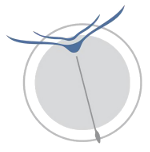Long‐distance avian flyers facing hardship in all cardinal directions: comparing north‐south migration of waterbirds along the western and the eastern Palearctic flyways
Since early history of mankind, migrating birds have attracted human attention, and scientists
have strived to understand this fascinating natural phenomenon. The long history of bird
migration research has yielded many insights into the ecology and evolutionary biology of birds,
and the recent upsurge in wildlife telemetry technologies has drastically improve our ability to
track migration journeys of wild birds. Yet, our understanding of the interactions between
migrating birds and their changing environments is still rather limited, due to the inherent
difficulty in distinguishing the factors responsible for the observed patterns. We propose to
address this challenge by developing a comparative approach that will, for the first time,
examine conspecifics of the same three bird species migrating along the two largest and most
vulnerable flyways of the world, encountering different sets of challenges along their journeys.
Specifically, we will compare migration of waterbirds of three species – Mallards, Common
Cranes and Grey Herons – along the Western Palearctic‐African Flyway (WPAF) and the East
Asian‐Australasian Flyway (EAAF). We will GPS‐track hundreds of waterbirds throughout their
annual cycle, in their breeding and wintering sites and during their roundtrip migration. Tracking
devices will provide high‐resolution movement tracks, and data from 3D‐acceleration sensors
will be used to determine the behavior and energy expenditure of tracked birds. We will use
atmospheric models and global environmental datasets to compare the key physical, climatic
and human‐related factors affecting migrating birds in the two flyways. We will also estimate
carry‐over effects, survival and migration performance and use experimental field manipulations
to examine how migratory birds affect wetland ecosystems during winter. Overall, we expect to
reveal differences and similarities between the two flyways and the three study species in
movement, behavior, energy balance and survival of birds at all stages of their annual cycle. We
expect to contribute novel insights to the study of bird migration and ecosystem dynamics, and
to provide guidelines to land management and conservation efforts. These are critical now due
the global anthropogenic changes in land use and ecosystem deterioration, particularly in China,
which faces massive human population increase and rapid economic development threatening
the majority of birds migrating along the EAAF.
have strived to understand this fascinating natural phenomenon. The long history of bird
migration research has yielded many insights into the ecology and evolutionary biology of birds,
and the recent upsurge in wildlife telemetry technologies has drastically improve our ability to
track migration journeys of wild birds. Yet, our understanding of the interactions between
migrating birds and their changing environments is still rather limited, due to the inherent
difficulty in distinguishing the factors responsible for the observed patterns. We propose to
address this challenge by developing a comparative approach that will, for the first time,
examine conspecifics of the same three bird species migrating along the two largest and most
vulnerable flyways of the world, encountering different sets of challenges along their journeys.
Specifically, we will compare migration of waterbirds of three species – Mallards, Common
Cranes and Grey Herons – along the Western Palearctic‐African Flyway (WPAF) and the East
Asian‐Australasian Flyway (EAAF). We will GPS‐track hundreds of waterbirds throughout their
annual cycle, in their breeding and wintering sites and during their roundtrip migration. Tracking
devices will provide high‐resolution movement tracks, and data from 3D‐acceleration sensors
will be used to determine the behavior and energy expenditure of tracked birds. We will use
atmospheric models and global environmental datasets to compare the key physical, climatic
and human‐related factors affecting migrating birds in the two flyways. We will also estimate
carry‐over effects, survival and migration performance and use experimental field manipulations
to examine how migratory birds affect wetland ecosystems during winter. Overall, we expect to
reveal differences and similarities between the two flyways and the three study species in
movement, behavior, energy balance and survival of birds at all stages of their annual cycle. We
expect to contribute novel insights to the study of bird migration and ecosystem dynamics, and
to provide guidelines to land management and conservation efforts. These are critical now due
the global anthropogenic changes in land use and ecosystem deterioration, particularly in China,
which faces massive human population increase and rapid economic development threatening
the majority of birds migrating along the EAAF.
Status:
Currently In Progress



